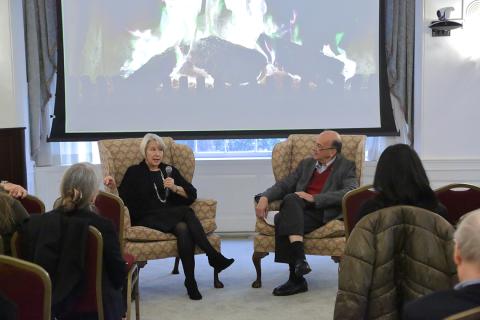You’re Never Too Old
Peace Corps Director Discusses Volunteer Opportunities

Photo: Ernie Branson
If you think you’re too old to experience the Peace Corps, think again. During a recent visit to NIH, agency director Carrie Hessler-Radelet described opportunities for people of all ages, noting that the oldest current volunteer is 87.
Hessler-Radelet said she found her passion for public health as a Peace Corps volunteer in the 1980s, teaching school in Western Samoa. She’s headed the organization since 2012 and has led extensive reforms to increase diversity, improve support for its volunteers and increase the impact of their work. The agency’s mission is to promote world peace and friendship by providing trained volunteers who can encourage mutual understanding between the U.S. and the more than 60 participating countries.
Fogarty International Center director Dr. Roger Glass hosted Hessler-Radelet for a “fireside chat” at Stone House to discuss volunteer opportunities, including those related to global health and research. They also reflected on overlapping interests between the Peace Corps and NIH. Both are engaged in capacity-building of health care workers in Africa and the Peace Corps is involved in implementation research and evaluations in diseases ranging from malaria to cervical cancer.
While the majority of people who serve are in their 20s, about 9 percent are over the age of 50. Of that group, most are older than 60, Hessler-Radelet estimated. “They are retirees who still have a lot of energy and want to use their skills and talents.”
Federal workers who are nearing retirement but haven’t done so yet can go into the Peace Corps, continue to accrue benefits and postpone retirement by several years, she explained, adding, “It’s a great strategy.”
The Peace Corps can also be a springboard into the federal workforce. Volunteers who successfully complete their service qualify for noncompetitive eligibility hiring status. And they bring back “an amazing skill set,” according to Mitzi Kosciulek of the NIH Office of Human Resources, who joined in the discussion. She said more than half the people NIH recruiters meet at Peace Corps job fairs are referred on to hiring managers for consideration.
“They were the best years of my life,” said returning volunteer Colleen Dundas, who served in Malawi from 2013 to 2015 and now works on national outreach efforts in the NIAMS Office of Science Policy, Planning and Communications. “I learned so much in terms of resiliency, understanding people, skills you can’t even put on a resumé and skills you can, like program management, grant writing and public health work.”
In addition to the well-known 2-year program, Hessler-Radelet pointed out that there also are short-term service opportunities. The Peace Corps Response program places experienced professionals in specialized assignments lasting 3 to 12 months. And the Global Health Service Partnership program recruits doctors and nurses with a U.S. license for 1-year assignments teaching in medical and nursing schools in developing countries. It currently operates in Liberia, Malawi, Tanzania, Swaziland and Uganda.
People interested in joining the Peace Corps can now choose to apply to specific programs and countries, selecting the path that best fits their personal and professional goals; the revised online application process takes about an hour to complete.
“I’ve followed the Peace Corps since President John F. Kennedy put it in place,” Glass said as the gathering wound down. “The idea that you have people of all ages providing service in an incredibly unique way is really wonderful.”
More information can be found at www.peacecorps.gov.
